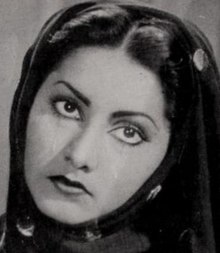Meena Shorey | |
|---|---|
 Shorey in Actress (1948) | |
| Born | Khurshid Jehan 13 November 1921 |
| Died | 3 September 1989 (aged 67) |
| Resting place | Lahore |
| Other names | The Droll Queen of Partition[1] Lux Lady of Pakistan[2] The Lara Lappa Girl[2] The Comedienne of Calibre[2] |
| Occupation | Actress |
| Years active | 1941–1983 |
| Spouses | Al Nasir
(m. 1943; div. 1945)Roop K. Shorey
(m. 1948; div. 1956)Asad Bukhari
(m. 1962; div. 1968) |
| Children | 3 |
| Awards | Special Nigar Award for 30 years of excellence in Pakistani film industry in 1982 |
Meena Shorey (13 November 1921 – 3 September 1989) was a Pakistani film actress who worked first in Indian cinema and later Pakistani cinema. She appeared in Hindi/Urdu and Punjabi films. Credited in films by her mononym, Meena, her real name was Khurshid Jehan. She started her acting career playing a character role, as Ambhi, Raja of Taxila's sister in Sohrab Modi's Sikandar (1941). Married to her fourth husband, Roop K. Shorey, by the mid-1940s, she found fame when she acted in her husband's film Ek Thi Larki (1949), opposite actor Motilal. The story was written by I. S. Johar, who also starred in the film. The "foot-tapping" music composed by Vinod became a "huge hit", with Meena becoming an "icon" for the "new liberated" young women. Meena was acclaimed as the "Lara Lappa Girl", from the song of same title in the film.[3] She was one of the first women to be recognised in Indian cinema as a "comedienne of calibre".[4] She was also popularly known as The Droll Queen of Partition as she worked as a comedienne [Droll] in both in India and Pakistan [countries resulting from partition].[1]
In 1956, she went to Lahore, Pakistan with her husband, where they were invited by Pakistani producer J.C. Anand to make a film there following her mass popularity with the public in both India and Pakistan. The film Shorey made was Miss 56, a copy of the Guru Dutt-Madhubala starrer Mr. & Mrs. '55. Instead of returning to India when her husband did, she decided to stay back in Pakistan, continuing her acting career there.[5] Some of her best films in India included the Punjabi film Chaman (1948), Actress (1948), Ek Thi Ladki (1949), Dholak (1951), and Ek Do Teen (1953).
- ^ a b Dancing Women: Choreographing Corporeal Histories of Hindi Cinema. New York, NY : Oxford University Press. p. 234.
- ^ a b c "In memory of the 'Lara Lappa Girl'". The News International. 28 April 2022.
- ^ Sanjit Narwekar (12 December 2012). "13-The Image Manipulators". Eena Meena Deeka: The Story of Hindi Film Comedy. Rupa Publications. pp. 182–. ISBN 978-81-291-2625-2. Retrieved 25 September 2019.
- ^ Sanjit Narwekar (12 December 2012). "14-The Female Of The Species". Eena Meena Deeka: The Story of Hindi Film Comedy. Rupa Publications. pp. 182–. ISBN 978-81-291-2625-2. Retrieved 25 September 2019.
- ^ Maneesha Tikekar (2004). "Pakistani Silver Screen-Lollywood". Across the Wagah: An Indian's Sojourn in Pakistan. Bibliophile South Asia. pp. 326–. ISBN 978-81-85002-34-7. Retrieved 25 September 2019.